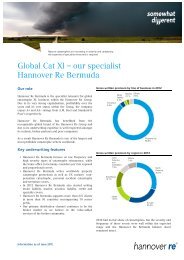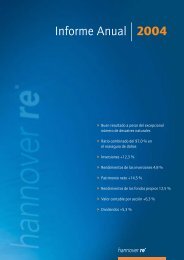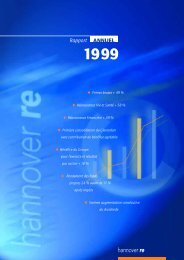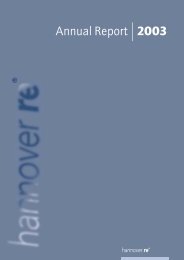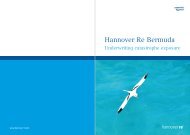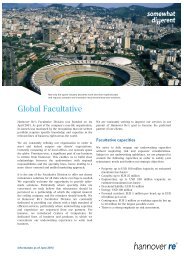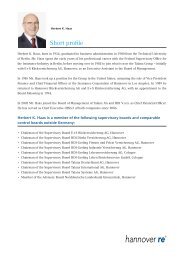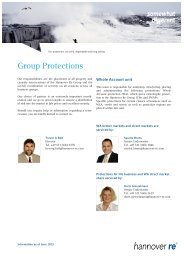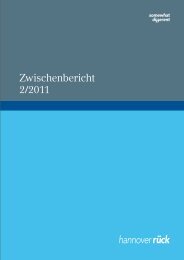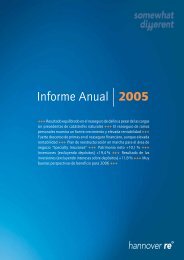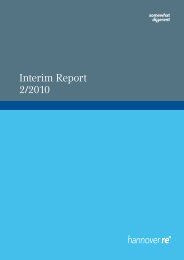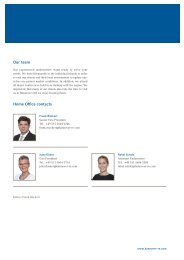Annual Report 2010 - Hannover Re
Annual Report 2010 - Hannover Re
Annual Report 2010 - Hannover Re
You also want an ePaper? Increase the reach of your titles
YUMPU automatically turns print PDFs into web optimized ePapers that Google loves.
Limits and thresholds for the 100- and 200-year aggregate annual loss as well as utilisation thereof<br />
Natural catastrophes and aggregate<br />
annual losses in EUR million<br />
All natural catastrophe risks, net exposure<br />
Limit <strong>2010</strong> Threshold <strong>2010</strong><br />
Actual utilisation<br />
(July <strong>2010</strong>)<br />
100-year aggregate annual loss 1,010 909 883<br />
200-year aggregate annual loss 1,209 1,088 1,072<br />
The development of the combined ratio in non-life reinsurance<br />
is shown in the table below.<br />
Technical risks in life and health reinsurance<br />
All risks directly connected with the life of an insured person<br />
are referred to as biometric risks (especially the miscalculation<br />
of mortality, life expectancy, morbidity and occupational disability);<br />
they constitute material risks for our company in the<br />
area of life and health reinsurance. Counterparty, lapse and<br />
catastrophe risks are also material since we additionally prefinance<br />
our cedants’ new business acquisition costs. As in<br />
non-life reinsurance, the reserves are essentially calculated<br />
according to information provided by our clients and are also<br />
determined on the basis of secure biometric actuarial bases.<br />
Through our quality assurance measures we ensure that the<br />
reserves established by ceding companies in accordance with<br />
local accounting principles satisfy all requirements with respect<br />
to the calculation methods used and assumptions made<br />
(e.g. use of mortality and morbidity tables, assumptions regarding<br />
the lapse rate). New business is written in all regions<br />
in compliance with underwriting guidelines applicable worldwide,<br />
which set out detailed rules governing the type, quality,<br />
level and origin of risks. These global guidelines are revised<br />
annually and approved by the Executive Board. Special underwriting<br />
guidelines give due consideration to the particular<br />
features of individual markets.<br />
By monitoring compliance with these underwriting guidelines<br />
we minimise the potential credit risk stemming from an inability<br />
to pay or deterioration in the financial status of cedants.<br />
<strong>Re</strong>gular reviews and holistic analyses (e.g. with an eye to lapse<br />
risks) are carried out with respect to new business activities<br />
and the assumption of international portfolios. The interest<br />
rate risk, which in the primary sector is important in life business<br />
owing to the guarantees that are given, is of only minimal<br />
relevance to our company owing to the structure of the contracts.<br />
The actuarial reports and documentation required by<br />
local regulators ensure that regular scrutiny also takes place<br />
on the level of the subsidiaries.<br />
The Market Consistent Embedded Value (MCEV) is a ratio<br />
used for the valuation of life insurance and reinsurance business;<br />
it is calculated as the present value of the future shareholders’<br />
earnings from the worldwide life and health reinsurance<br />
portfolio plus the allocated capital. The calculation makes<br />
allowance as far as possible for all risks underlying the covered<br />
business. The Market Consistent Embedded Value is established<br />
on the basis of the principles of the CFO Forum published<br />
in October 2009. Based on the latest available data<br />
Stress tests for natural catastrophes after retrocessions in EUR million <strong>2010</strong> 2009<br />
Effect on forecast net income<br />
100-year loss European windstorm (146,5) (114,7)<br />
100-year loss US windstorm (259,8) (281,8)<br />
100-year loss Japanese windstorm (189,4) (204,3)<br />
100-year loss Tokyo earthquake (195,1) (201,4)<br />
100-year loss California earthquake (233,1) (244,9)<br />
100-year loss Sydney earthquake (72,5) (150,6)<br />
Combined and catastrophe loss ratio over the past ten years in %<br />
<strong>2010</strong> 2009 2008 2007 2006 2005 1 2004 1,2 2003 1,2 2002 1,2 2001 1,2<br />
Combined ratio<br />
(non-life reinsurance) 98.2 96.6 95.4 99.7 100.8 112.8 97.2 96.0 96.3 116.5<br />
Thereof catastrophe losses 3 12.3 4.6 10.7 6.3 2.3 26.3 8.3 1.5 5.2 23.0<br />
1 Incl. financial reinsurance and specialty insurance<br />
2 Based on US GAAP figures<br />
3 Natural catastrophes and other man-made major losses > EUR 5 million gross for the share of the <strong>Hannover</strong> <strong>Re</strong> Group as a percentage of<br />
net premium earned<br />
62 Management report opportunity and risk report<br />
<strong>Hannover</strong> <strong>Re</strong> Group annual report <strong>2010</strong>



